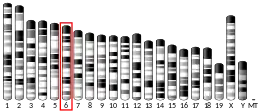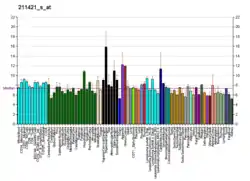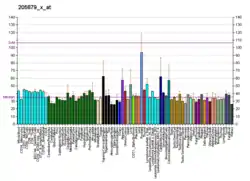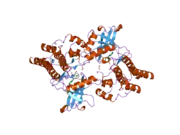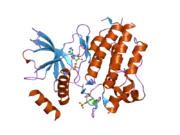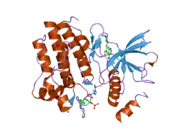RET proto-oncogene
The RET proto-oncogene encodes a receptor tyrosine kinase for members of the glial cell line-derived neurotrophic factor (GDNF) family of extracellular signalling molecules.[5] RET loss of function mutations are associated with the development of Hirschsprung's disease, while gain of function mutations are associated with the development of various types of human cancer, including medullary thyroid carcinoma, multiple endocrine neoplasias type 2A and 2B, pheochromocytoma and parathyroid hyperplasia.
Structure
RET is an abbreviation for "rearranged during transfection", as the DNA sequence of this gene was originally found to be rearranged within a 3T3 fibroblast cell line following its transfection with DNA taken from human lymphoma cells.[6] The human gene RET is localized to chromosome 10 (10q11.2) and contains 21 exons.[7]
The natural alternative splicing of the RET gene results in the production of 3 different isoforms of the protein RET. RET51, RET43 and RET9 contain 51, 43 and 9 amino acids in their C-terminal tail respectively.[8] The biological roles of isoforms RET51 and RET9 are the most well studied in-vivo as these are the most common isoforms in which RET occurs.
Common to each isoform is a domain structure. Each protein is divided into three domains: an N-terminal extracellular domain with four cadherin-like repeats and a cysteine-rich region, a hydrophobic transmembrane domain and a cytoplasmic tyrosine kinase domain, which is split by an insertion of 27 amino acids. Within the cytoplasmic tyrosine kinase domain, there are 16 tyrosines (Tyrs) in RET9 and 18 in RET51. Tyr1090 and Tyr1096 are present only in the RET51 isoform.[9]
The extracellular domain of RET contains nine N-glycosylation sites. The fully glycosylated RET protein is reported to have a molecular weight of 170 kDa although it is not clear to which isoform this molecular weight relates.[10]
Kinase activation
RET is the receptor for GDNF-family ligands (GFLs).[11]
In order to activate RET, GFLs first need to form a complex with a glycosylphosphatidylinositol (GPI)-anchored co-receptor. The co-receptors themselves are classified as members of the GDNF receptor-α (GFRα) protein family. Different members of the GFRα family (GFRα1, GFRα2, GFRα3, GFRα4) exhibit a specific binding activity for a specific GFLs.[12] Upon GFL-GFRα complex formation, the complex then brings together two molecules of RET, triggering trans-autophosphorylation of specific tyrosine residues within the tyrosine kinase domain of each RET molecule. Tyr900 and Tyr905 within the activation loop (A-loop) of the kinase domain have been shown to be autophosphorylation sites by mass spectrometry.[13] Phosphorylation of Tyr905 stabilizes the active conformation of the kinase, which, in turn, results in the autophosphorylation of other tyrosine residues mainly located in the C-terminal tail region of the molecule.[9]

The structure shown to the left was taken from the protein data bank code 2IVT.[5] The structure is that of a dimer formed between two protein molecules each spanning amino acids 703-1012 of the RET molecule, covering RETs intracellular tyrosine kinase domain. One protein molecule, molecule A is shown in yellow and the other, molecule B in grey. The activation loop is coloured purple and selected tyrosine residues in green. Part of the activation loop from molecule B is absent.
Phosphorylation of Tyr981 and the additional tyrosines Tyr1015, Tyr1062 and Tyr1096, not covered by the above structure, have been shown to be important to the initiation of intracellular signal transduction processes.
Role of RET signalling during development
Mice deficient in GDNF, GFRα1 or the RET protein itself exhibit severe defects in kidney and enteric nervous system development. This implicates RET signal transduction as key to the development of normal kidneys and the enteric nervous system.[9]
Clinical relevance
Activating point mutations in RET can give rise to the hereditary cancer syndrome known as multiple endocrine neoplasia type 2 (MEN 2).[14] There are three subtypes based on clinical presentation: MEN 2A, MEN 2B, and familial medullary thyroid carcinoma (FMTC).[15] There is a high degree of correlation between the position of the point mutation and the phenotype of the disease.
Chromosomal rearrangements that generate a fusion gene, resulting in the juxtaposition of the C-terminal region of the RET protein with an N-terminal portion of another protein, can also lead to constitutive activation of the RET kinase. These types of rearrangements are primarily associated with papillary thyroid carcinoma (PTC) where they represent 10-20% of cases, and non-small cell lung cancer (NSCLC) where they represent 2% of cases. Several fusion partners have been described in the literature, and the most common ones across both cancer types include KIF5B, CCDC6 and NCOA4.
While older multikinase inhibitors such as cabozantinib or vandetanib showed modest efficacy in targeting RET-driven malignancies, newer selective inhibitors (such as selpercatinib and pralsetinib) have shown significant activity in both mutations and fusions. The results of the LIBRETTO-001 trial studying selpercatinib showed a progression-free survival of 17.5 months in previously treated RET-positive NSCLC, and 22 months for RET-positive thyroid cancers, which prompted an FDA approval for both these indications in May 2020. Several other selective RET inhibitors are under development, including TPX-0046, a macrocyclic inhibitor of RET and Src intended to inhibit mutations providing resistance to current inhibitors.
Disease database
The RET gene variant database at the University of Utah, identifies (as of November 2014) 166 mutations that are implicated in MEN2.
Interactions
RET proto-oncogene has been shown to interact with:
References
- GRCh38: Ensembl release 89: ENSG00000165731 - Ensembl, May 2017
- GRCm38: Ensembl release 89: ENSMUSG00000030110 - Ensembl, May 2017
- "Human PubMed Reference:". National Center for Biotechnology Information, U.S. National Library of Medicine.
- "Mouse PubMed Reference:". National Center for Biotechnology Information, U.S. National Library of Medicine.
- Knowles PP, Murray-Rust J, Kjaer S, et al. (2006). "Structure and chemical inhibition of the RET tyrosine kinase domain". J. Biol. Chem. 281 (44): 33577–87. doi:10.1074/jbc.M605604200. PMID 16928683.
- Takahashi M, Ritz J, Cooper GM (1985). "Activation of a novel human transforming gene, ret, by DNA rearrangement". Cell. 42 (2): 581–8. doi:10.1016/0092-8674(85)90115-1. PMID 2992805. S2CID 13567823.
- Ceccherini I, Bocciardi R, Luo Y, et al. (1993). "Exon structure and flanking intronic sequences of the human RET proto-oncogene". Biochem. Biophys. Res. Commun. 196 (3): 1288–1295. doi:10.1006/bbrc.1993.2392. PMID 7902707.
- Myers SM, Eng C, Ponder BA, et al. (1995). "Characterization of RET proto-oncogene 3' splicing variants and polyadenylation sites: a novel C-terminus for RET". Oncogene. 11 (10): 2039–2045. PMID 7478523.
- Arighi E, Borrello MG, Sariola H (2005). "RET tyrosine kinase signaling in development and cancer". Cytokine Growth Factor Rev. 16 (4–5): 441–67. doi:10.1016/j.cytogfr.2005.05.010. PMID 15982921.
- Takahashi M, Asai N, Iwashita T, et al. (1993). "Characterization of the ret proto-oncogene products expressed in mouse L cells". Oncogene. 8 (11): 2925–2929. PMID 8414495.
- Baloh RH, Enomoto H, Johnson EM, et al. (2000). "The GDNF family ligands and receptors - implications for neural development". Curr. Opin. Neurobiol. 10 (1): 103–10. doi:10.1016/S0959-4388(99)00048-3. PMID 10679429. S2CID 32315320.
- Airaksinen MS, Titievsky A, Saarma M (1999). "GDNF family neurotrophic factor signaling: four masters, one servant?". Mol. Cell. Neurosci. 13 (5): 313–25. doi:10.1006/mcne.1999.0754. PMID 10356294. S2CID 46427535.
- Kawamoto Y, Takeda K, Okuno Y, et al. (2004). "Identification of RET autophosphorylation sites by mass spectrometry". J. Biol. Chem. 279 (14): 14213–24. doi:10.1074/jbc.M312600200. PMID 14711813.
- Online Mendelian Inheritance in Man (OMIM): MULTIPLE ENDOCRINE NEOPLASIA, TYPE IIA; MEN2A - 171400
- Qi XP, Ma JM, Du ZF, Ying RB, Fei J, Jin HY, Han JS, Wang JQ, Chen XL, Chen CY, Liu WT, Lu JJ, Zhang JG, Zhang XN (2011). "RET germline mutations identified by exome sequencing in a Chinese multiple endocrine neoplasia type 2A/familial medullary thyroid carcinoma family". PLOS ONE. 6 (5): e20353. Bibcode:2011PLoSO...620353Q. doi:10.1371/journal.pone.0020353. PMC 3105051. PMID 21655256.
- Murakami H, Yamamura Y, Shimono Y, Kawai K, Kurokawa K, Takahashi M (September 2002). "Role of Dok1 in cell signaling mediated by RET tyrosine kinase". J. Biol. Chem. 277 (36): 32781–90. doi:10.1074/jbc.M202336200. PMID 12087092.
- Crowder RJ, Enomoto H, Yang M, Johnson EM, Milbrandt J (October 2004). "Dok-6, a Novel p62 Dok family member, promotes Ret-mediated neurite outgrowth". J. Biol. Chem. 279 (40): 42072–81. doi:10.1074/jbc.M403726200. PMID 15286081.
- Grimm J, Sachs M, Britsch S, Di Cesare S, Schwarz-Romond T, Alitalo K, Birchmeier W (July 2001). "Novel p62dok family members, dok-4 and dok-5, are substrates of the c-Ret receptor tyrosine kinase and mediate neuronal differentiation" (PDF). J. Cell Biol. 154 (2): 345–54. doi:10.1083/jcb.200102032. PMC 2150770. PMID 11470823.
- Klein RD, Sherman D, Ho WH, Stone D, Bennett GL, Moffat B, Vandlen R, Simmons L, Gu Q, Hongo JA, Devaux B, Poulsen K, Armanini M, Nozaki C, Asai N, Goddard A, Phillips H, Henderson CE, Takahashi M, Rosenthal A (June 1997). "A GPI-linked protein that interacts with Ret to form a candidate neurturin receptor". Nature. 387 (6634): 717–21. doi:10.1038/42722. PMID 9192898. S2CID 4360246.
- Cik M, Masure S, Lesage AS, Van Der Linden I, Van Gompel P, Pangalos MN, Gordon RD, Leysen JE (September 2000). "Binding of GDNF and neurturin to human GDNF family receptor alpha 1 and 2. Influence of cRET and cooperative interactions". J. Biol. Chem. 275 (36): 27505–12. doi:10.1074/jbc.M000306200. PMID 10829012.
- Pandey A, Duan H, Di Fiore PP, Dixit VM (September 1995). "The Ret receptor protein tyrosine kinase associates with the SH2-containing adapter protein Grb10". J. Biol. Chem. 270 (37): 21461–3. doi:10.1074/jbc.270.37.21461. PMID 7665556.
- Pandey A, Liu X, Dixon JE, Di Fiore PP, Dixit VM (May 1996). "Direct association between the Ret receptor tyrosine kinase and the Src homology 2-containing adapter protein Grb7". J. Biol. Chem. 271 (18): 10607–10. doi:10.1074/jbc.271.18.10607. PMID 8631863.
- Borrello MG, Pelicci G, Arighi E, De Filippis L, Greco A, Bongarzone I, Rizzetti M, Pelicci PG, Pierotti MA (June 1994). "The oncogenic versions of the Ret and Trk tyrosine kinases bind Shc and Grb2 adaptor proteins". Oncogene. 9 (6): 1661–8. PMID 8183561.
- Arighi E, Alberti L, Torriti F, Ghizzoni S, Rizzetti MG, Pelicci G, Pasini B, Bongarzone I, Piutti C, Pierotti MA, Borrello MG (February 1997). "Identification of Shc docking site on Ret tyrosine kinase". Oncogene. 14 (7): 773–82. doi:10.1038/sj.onc.1200896. PMID 9047384.
- Yuan ZL, Guan YJ, Wang L, Wei W, Kane AB, Chin YE (November 2004). "Central role of the threonine residue within the p+1 loop of receptor tyrosine kinase in STAT3 constitutive phosphorylation in metastatic cancer cells". Mol. Cell. Biol. 24 (21): 9390–400. doi:10.1128/MCB.24.21.9390-9400.2004. PMC 522220. PMID 15485908.
- Hwang JH, Kim DW, Suh JM, Kim H, Song JH, Hwang ES, Park KC, Chung HK, Kim JM, Lee TH, Yu DY, Shong M (June 2003). "Activation of signal transducer and activator of transcription 3 by oncogenic RET/PTC (rearranged in transformation/papillary thyroid carcinoma) tyrosine kinase: roles in specific gene regulation and cellular transformation". Mol. Endocrinol. 17 (6): 1155–66. doi:10.1210/me.2002-0401. PMID 12637586.
- Schuringa JJ, Wojtachnio K, Hagens W, Vellenga E, Buys CH, Hofstra R, Kruijer W (August 2001). "MEN2A-RET-induced cellular transformation by activation of STAT3". Oncogene. 20 (38): 5350–8. doi:10.1038/sj.onc.1204715. PMID 11536047.
Further reading
- Eng C, Mulligan LM (1997). "Mutations of the RET proto-oncogene in the multiple endocrine neoplasia type 2 syndromes, related sporadic tumours, and hirschsprung disease". Hum. Mutat. 9 (2): 97–109. doi:10.1002/(SICI)1098-1004(1997)9:2<97::AID-HUMU1>3.0.CO;2-M. PMID 9067749.
- Hofstra RM, Osinga J, Buys CH (1998). "Mutations in Hirschsprung disease: when does a mutation contribute to the phenotype". Eur. J. Hum. Genet. 5 (4): 180–5. doi:10.1159/000484760. PMID 9359036.
- Nikiforov YE (2002). "RET/PTC rearrangement in thyroid tumors". Endocr. Pathol. 13 (1): 3–16. doi:10.1385/EP:13:1:03. PMID 12114746. S2CID 23964165.
- Santoro M, Melillo RM, Carlomagno F, et al. (2004). "Minireview: RET: normal and abnormal functions". Endocrinology. 145 (12): 5448–5451. doi:10.1210/en.2004-0922. PMID 15331579.
- Santoro M, Carlomagno F, Melillo RM, Fusco A (2005). "Dysfunction of the RET receptor in human cancer". Cell. Mol. Life Sci. 61 (23): 2954–2964. doi:10.1007/s00018-004-4276-8. PMID 15583857.
- Niccoli-Sire P, Conte-Devolx B (2005). "[RET mutations and preventive treatment of medullary thyroid cancer]". Ann. Endocrinol. 66 (3): 168–75. doi:10.1016/s0003-4266(05)81748-2. PMID 15988377.
- Lantieri F, Griseri P, Ceccherini I (2006). "Molecular mechanisms of RET-induced Hirschsprung pathogenesis". Ann. Med. 38 (1): 11–9. doi:10.1080/07853890500442758. PMID 16448984. S2CID 43686346.
- Ciampi R, Nikiforov YE (2007). "RET/PTC rearrangements and BRAF mutations in thyroid tumorigenesis". Endocrinology. 148 (3): 936–41. doi:10.1210/en.2006-0921. PMID 16946010.
- Plaza-Menacho I, Burzynski GM, de Groot JW, et al. (2007). "Current concepts in RET-related genetics, signaling and therapeutics" (PDF). Trends Genet. 22 (11): 627–36. doi:10.1016/j.tig.2006.09.005. PMID 16979782.
External links
- GeneReviews/NCBI/NIH/UW entry on Multiple Endocrine Neoplasia Type 2
- ret+Proto-Oncogene+Proteins at the US National Library of Medicine Medical Subject Headings (MeSH)


